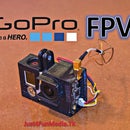Introduction: $5 Quadcopter Anti-Vibration, Torsion, Stabilizeation Mount
This inexpensive torsion mount removes jitters and Jello Effect (Vibrational Aberration) from your quadcopter (I used a Syma X8) video. This setup is suited for a GoPro, but the quarter inch mounting system is compatible with all tripod mounts, including point and shoot cameras. The mount is adjustable 170 degrees vertically and 360 degrees horizontally (photo 2).
.
Check out The Build and Testing Video
.
For this project you will require the following...
Materials:
Super glue
Fibreglass Torsion Mount (http://www.gearbest.com/rc-parts/pp_2702 2.html)
GoPro Tripod Adapter (http://www.gearbest.com/photography-accessories/pp_139405.html)
Quarter Inch Bolt
Washer
25lb Fishing Line
GoPro Surfboard Security Mount
.
Tools:
Drill and Quarter Inch Drill Bit
Sandpaper (Approximately 120 grit)
Screwdriver and/or Wrench
Vise Grip and Grinding Wheel (If your bolt is too long)
.
You can find the Syma X8 Here:
http://www.gearbest.com/rc-quadcopters/pp_193218.html
.
Check Out Our Other Accounts! Like, Subscribe, and Follow to keep up to date with our latest projects. :-)
Step 1: Position the Baseplate
Position and trace the base plate of the torsion mount onto the base of the quadcopter. Ensure that there is enough clearance for the stock camera to be plugged in and for the power switch to function.
Step 2: Sanding
Sand the contact areas of the base plate and quadcopter using a medium grit sandpaper, I used 120.
Step 3: Super Glue
Apply a thin layer of super glue to the contact area of the base plate then firmly press the base plate onto the quadcopter. Next apply additional super glue around the edges of the base plate, once again ensuring not to interfere with the power switch or camera plug.
Step 4: Camera Mount
Drill a quarter inch hole in the centre of the upper plate of the torsion mount. Use the quarter inch bolt to thread the hole in the upper plate. If the bolt head to too large to fit between the plates you will need to shorten it using a grinding wheel.
Step 5: GoPro Mount Assembly
Place the ground off bold through the washer, then thread the bolt into the quarter inch hole in the upper plate of the torsion mount and the GoPro Tripod Mount. The use of the quarter inch bolt allows for the attachment of any tripod compatible camera.
Step 6: Final Assembly
Place the rubber links between the holes in the upper and base plates of the torsion mount. Using a loop of fishing line to aid in "popping" the links in place if necessary.
Step 7: Added Security
Since the camera will be suspended in mid air I threaded 25 pound fishing line through each of the rubber links and tied off the loops with surgeon knots. I then rotated the knots so the they are hidden inside the rubber links.
I also attached a surfboard security mount and a catch cable to the side of the quadcopter to ensure that the GoPro says attached, even in the event of a full failure of the torsion mount.
Step 8: Testing
I have flown using the torsion mount on a few test flights so far. Vibrational aberration, aka "Jello Effect", has been almost not existent, even when yawing and fighting cross winds.
https://youtu.be/CGxib2KrUsE?t=4m
Sadly after shooting the test video above I lost control of the quadcopter and as of writing this tutorial it has not been recovered. I guess my next project will be a locator beacon to find downed RC aircraft.
Have a great day! Post any questions and photos below.

Participated in the
Make it Move Contest 2016

Participated in the
Robotics Contest 2016

Participated in the
String Challenge




















